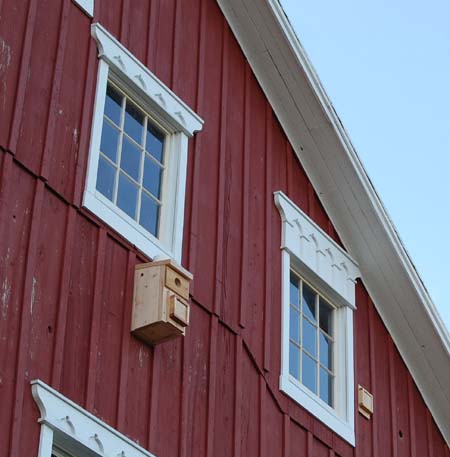
Richard and Diane Van Vleck Personal Pages The Home Habitat |

2. Lacking natural nest sites, flickers will often attempt to excavate the hollow sounding walls of homes, especially with stucco or relatively soft cedar siding. The resulting severe property damage can usually be prevented by promptly installing a nest box on the wall near the damage or on a post nearby.
3. Use a flicker box to attract yet another cavity nesting species to your yard. A diverse habitat, including a variety of nest boxes, leads to a diversity of species.
4. Although still a common species, flicker populations are in significant decline, likely due to loss of snags and unyielding competition from European starlings.
5. Flickers frequently use nest boxes for winter roosts. The male flicker in our yard is spending every night in the new nest box (late December, 2008) while his mate roosts under the eave of the barn. He found the box 2 hours after I placed it on the wall Dec 4th and has used it ever since. A second box was placed on the same wall today to see if the female will use it. They never enter a nest box together, even when nesting. 1/11/09 Update The female flicker entered and inspected the exterior nest box today, but she is still roosting under the eave at night. The male spends every night in the interior box. His entrance hole is visible at the far right in the top photo. The photo at the bottom of the page is a video frame capture of the female flicker's visit to the outside box today. The box is seen in the top photo.
The disadvantage of the new box is its weight of approximately 18 lbs. However, a very easy method of mounting the box to a pole or wall makes both placing and removing the box a snap. A large keyhole on the back of the box slips over a 1/2" lag bolt, allowing one handed mounting and removal. The weight keeps the box level, even when mounted on a round pole.
 The 4" diameter camera housing serves both as a convenient way to mount a nest cam and as a large access port for filling the box with wood chips and emptying the box, if desired. While my earlier large boxes for kestrels, owls, and woodpeckers used side doors to empty nesting material, this is a very messy and unsanitary procedure when clinging to a ladder next to the box. This box is simply lifted off the lag bolt and lowered to the ground to empty through the cam port.
The 4" diameter camera housing serves both as a convenient way to mount a nest cam and as a large access port for filling the box with wood chips and emptying the box, if desired. While my earlier large boxes for kestrels, owls, and woodpeckers used side doors to empty nesting material, this is a very messy and unsanitary procedure when clinging to a ladder next to the box. This box is simply lifted off the lag bolt and lowered to the ground to empty through the cam port.

| barn owl | American kestrel | purple martin | barn swallow | Eastern bluebird |
| tufted titmouse | Eastern phoebe | yellow shafted flicker | tree swallow | chimney swift |
| house wren | big brown bat | Carolina wren | brown thrasher | catbird |
| cedar waxwing | Northern mockingbird | |||
| Yellow warbler | Acadian flycatcher | |||
email richard@americanartifacts.com
© 2009, American Artifacts and Richard Van Vleck, Taneytown, Maryland.